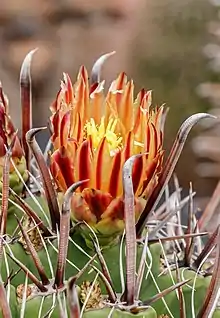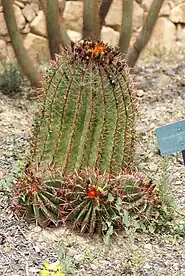Ferocactus herrerae
Ferocactus herrerae, commonly known as the twisted barrel cactus,[3][4][5] Herrera's barrel cactus,[6] or the biznaga[4] (in Classical Nahuatl), is a species of viviparous barrel cactus in the genus Ferocactus of the family Cactaceae that is native to southwestern Sonora to the northwestern coastline of Sinaloa in western Mexico.[7] It was described by Mexican botanist, Jesús González Ortega in 1927.[8] Its common name refers to its twisted, barrel cactus shape habit, with long, hooked, or barbed spines.[3]
| Ferocactus herrerae | |
|---|---|
.jpg.webp) | |
| In Guamúchil, Sinaloa, Mexico | |
 | |
| Flower details | |
| Scientific classification | |
| Kingdom: | Plantae |
| Clade: | Tracheophytes |
| Clade: | Angiosperms |
| Clade: | Eudicots |
| Order: | Caryophyllales |
| Family: | Cactaceae |
| Subfamily: | Cactoideae |
| Genus: | Ferocactus |
| Species: | F. herrerae |
| Binomial name | |
| Ferocactus herrerae J.G.Ortega, 1927 | |
| Synonyms | |
| |
F. herrerae reaches an average height of 2 m (6.56 ft), and 40 cm (15.74 in) in diameter. 7-9 spines, with supposed bristle-like radials. Flowers are yellow, with red-pink midribs and brown tips, blooming from Summer to early Autumn. Fruit are yellow-green and fleshy. Areoles are 2.03 cm long.[3] It starts out in a globular barrel cactus form and eventually, as it matures, developing into a signature cylindrical barrel cactus form.[9]
Taxonomy
Ferocactus herrerae was originally listed as a subspecies or variety of Ferocactus wislizeni until it was elevated to full species status based on morphological differences.[8] The prior treatment is still used by some authors.[3]
Distribution and habitat
Ferocactus herrerae is native to portions of coastal southwestern Sonora to the northwestern coastline of Sinaloa in western Mexico, at elevations of under 400 m in coastal plains or semi-arid to arid shrubland.[7] Its range is sometimes said to extend into extreme western Durango.[8]
Conservation
Ferocactus herrerae was assessed and listed as "Vulnerable" by the IUCN Red List (International Union for Conservation of Nature), for agricultural land clearance and conversion, combined with shrimp farming practices have greatly limited populations. Its current population is decreasing at a rate of 30%.[7] It may also be provided a source of protection from CITES Appendix ll, though this cannot be certain.[10]
Uses
Ferocactus herrerae is commonly used as an ornamental cactus out of its native range.[9] Its seeds can be ground into flour, and its fruit are edible,[11] showing numerous positive nutritional aspects.[12]
Ecology
Ferocactus herrerae is commonly pollinated by various cactus bee species (Lithurgus spp.).
Gallery


.jpg.webp)
 As an ornamental cactus
As an ornamental cactus.jpg.webp)
References
- https://www.iucnredlist.org/species/151948/121514608
- https://www.speciesplus.net/species#/taxon_concepts/29073/legal
- "Ferocactus herrerae". www.llifle.com. Retrieved 2023-08-02.
- "Alamos Succs; Ferocactus herrerae (twisted barrel cactus, biznaga)". www.desertmuseum.org. Retrieved 2023-08-02.
- "Twisted Barrel Cactus". Project Noah. Retrieved 2023-08-02.
- Yetman, David (July 1, 2006). "A rare ring form of Herrera's Barrel Cactus, Ferocactus herrerae". Cactus and Succulent Journal. 78 (4) – via ResearchGate.
- IUCN (2010-05-11). Ferocactus herrerae: Burquez Montijo, A.: The IUCN Red List of Threatened Species 2017: e.T151948A121514608 (Report). International Union for Conservation of Nature. doi:10.2305/iucn.uk.2017-3.rlts.t151948a121514608.en.
- "Ferocactus herrerae J.G.Ortega | Plants of the World Online | Kew Science". Plants of the World Online. Retrieved 2023-08-02.
- "Ferocactus herrerae | The Cactus King". thecactusking.com. Retrieved 2023-08-02.
- "Species+". www.speciesplus.net. Retrieved 2023-08-02.
- "Ferocactus herrerae". www.cactus-art.biz. Retrieved 2023-08-02.
- Abdel-Baki, Ibrahim, Mahdy, Passent, Rana, Nariman (2022). "Ferocactus herrerae Fruits: Nutritional Significance, Phytochemical Profiling, and Biological Potentials". Plant Foods for Human Nutrition. 77 (1) – via ResearchGate.
{{cite journal}}: CS1 maint: multiple names: authors list (link)

